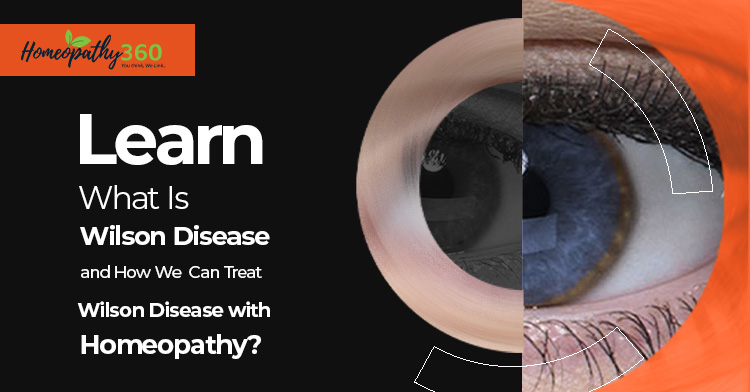
Learn What Is Wilson Disease and How We Can Treat Wilson Disease with Homeopathy?
Abstract – Wilson’s Disease is a rare inherited disorder that causes copper to accumulate in the liver, brain and other vital organs. The age group wherein the disease is diagnosed is between the ages of 5 and 35. Mostly the paediatric age group is being affected. Homoeopathy plays a great role in managing a case of Wilson’s disease. This system aims to strengthen the patient’s defence mechanism and plays an important role in the treatment of liver disorders.
Keywords : Wilson’s Disease, Homoeopathy. Hepatolenticular Degeneration
Definition – Hepatolenticular degeneration is an autosomal recessive disorder that can be associated with degenerative changes in the brain, liver disease, and Kayser-Fleischer rings in the cornea. It is fatal if untreated.
PATHOGENESIS
The abnormal gene for Wilson disease is localized to the long arm of chromosome 13 (13q14.3). A copper transporting p-type adenosine triphosphatase (ATPase), ATP7B malfunctioning results in decresed biliary copper excretion and diffuse accumulation of copper in the cytosol of hepatocytes. With time, liver cells become overloadedand copper is redistributed to other tissues, including brain and kidneys, causing toxicity.
CLINICAL FEATURES
Form of Wilsonian hepatic disease include asymptomatic hepatomegaly, subacute or chronic hepatitis, and acute hepatic failure. Cryptogenic cirrhosis, portal hypertension, ascites, edema, variceal bleeding, or other effects of hepatic dysfunction can be the manifestations.
The younger the patient, more likely hepatic involvement will be predominant manifestation. Girls are 3 times more likely than boys to present with acute hepatic failure.
Neurological disorders can develop with intention tremor, dysarthria, rigid dystonia, parkinsonism, choreiform movements, lack of motor coordination, deterioration in school performance, or behavioural changes. Kayser-Fleischer rings are present in some patients.
Psychiatric manifestations include depression, personality changes, anxiety, or psychosis.
Coombs-negative hemolytic anemia may be an initial manifestation.
Unusual manifestations include arthritis, pancreatitis, nephrolithiasis, infertility or recurrent miscarriages, cardiomyopathy and endocrinopathies.
PATHOLOGY
All grades of hepatic injury occur in patients with Wilson disease with steatosis, hepatocellular ballooning and degeneration, glycogen granules, minimal inflammation, and enlarged kupffer cells being most common. With progressive parenchymal damage, fibrosis and cirrhosis develop.
DIAGNOSIS
This condition should be considered with unexplained acute or chronic liver disease, neurologic symptoms of unknown cause, acute hemolysis, psychiatric illness, behavioural changes, Fanconi syndrome, or unexplained bone or muscle disease. The clinical suspicion is confirmed by study of indices of copper metabolism.
Decreased ceruloplasmin levels (<20 mg/Dl) will be seen. The serum free copper level may be elevated in early Wilson disease (1.6µmol/L), and urinary copper excretion ( usually <40µg/day) is increased to >100 µg/day.
Liver biopsy performd to determine the extent and severity of liver disease and for measuring hepatic copper content.
Screening of family members for presymptomatic Wilson disease
TREATMENT
A major attempt should be made to restrict dietary copper intake to <1mg/day.
Foods such as liver, shellfish, nuts and chocolate should be avoided.
If the copper content of the water exceeds 0.1 mg/dl, it may be necessary to dimeneralize the water. Treatment needs to be lifelong.
The initial treatment in symptomatic patients is the administration of copper- chelating agents, which lead to rapid excretion of of excess deposited copper.
Zinc can be used as an adjuvant therapy.
HOMOEOPATHIC MANAGEMENT:
- Bryonia alba : Soreness in liver region
Stitching, burning pain in abdomen, < pressure, coughing and sneezing
Hard swelling in the right side of abdomen and umbilical region.
Nausea and regurgitation of food after eating; vomiting of water and bile after eating Yellow, dark brown or white coating on tongue
Extreme dryness of skin, lips, mouth and throat along with extreme thirst.
Vertigo, nausea, dizziness on rising and confusion.
- Cardus Marianus
Congestion in brain, stroke, meningitis and neuralgia
Poor appetite with nausea and vomiting of green acid bile.
Bitter taste in mouth, A feeling of fullness and soreness along with pain in liver region while deep breathing.
Jaundice and cirrhosis
Hard, difficulty,clay-coloured stool alternating with diarrhea
Itching skin, especially on lying down at night
Easy bleeding and tendency to haemorrhage
Varicose veins and ulcers
- Chelidonium Majus
A tendency for gallstones with obstruction and enlargement of liver.
Jaundice with constant pain in the lower part of the right scapular region on the back.
Yellow tongue with a bitter taste in mouth along with bad breath.
Thirst with dryness of mouth and throat.
Constipation alternating with diarrhea.
Nausea and vomiting, which is relieved by drinking very hot water.
- Leptandra Virginica
Liver disease with jaundice
Sharp pain in the umbilical region
Black or clay-coloured stool
Yellow tongue with severe pain in liver region and vomiting of bile.
Weakness severe
Lycopodium Clavatum
Shooting pain in the abdomen that radiates from right to left
Distension and fullness of abdomen even after a light meal
Sensitive liver region
Brown spots on abdomen
Symptoms worsen between 4pm and 8pm.
Natrium Sulphuricum
Hepatitis with soreness and stitching, throbbing pain in the liver region.
Pain worsens while lying on the left side.
Abdominal pain extending to the chest with difficulty breathing
Yellow eyes and skin
NUX VOMICA
Colicky pain with soreness around the liver region. Severe constipation.
Vomitting causes relief
Phosphorous
A tendency for haemorrhages where even small wounds bleed profusely with bright red blood.
Jaundice, hepatitis with congested liver and yellow spots on abdomen.
Extreme weakness after passing stool or loss of body fluids through diarrhea
Craving for cold water
PROGNOSIS
Untreated patients with Wilson disease can die of hepatic, neurologic, renal, or hematologic complications. Liver transplantation should be considered for patients with fulminant disease, decompensated cirrhosis, or progressive neurologic disease.
References:
Piyush Gupta





